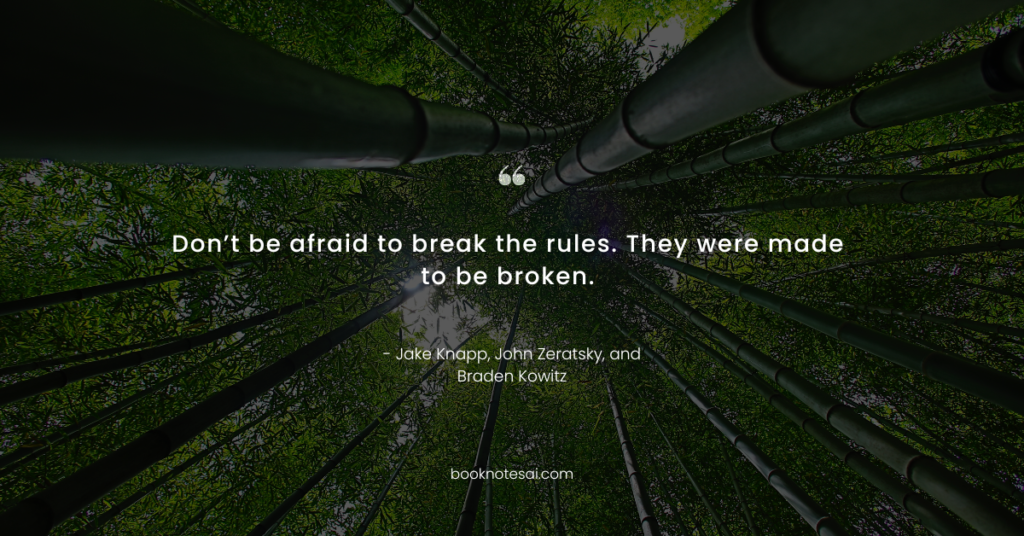Listen To This Post
A Proven Formula for Swift Innovation.
Sprint Summary: How to Solve Big Problems and Test New Ideas in Just Five Days.

This is a book summary for Sprint: How to Solve Big Problems and Test New Ideas in Just Five Days by Jake Knapp, John Zeratsky, and Braden Kowitz.
Introduction: Why this book?
- Discover how to swiftly tackle significant challenges and validate fresh concepts effectively in just five days.
- Invest your time in understanding the concepts presented in Sprint to unlock powerful problem-solving techniques and innovation strategies
Sprint Summary:
- Innovation Framework: The book introduces a structured framework, detailing how to compress the time needed for idea validation and decision-making.
- Problem Solving: It emphasizes the importance of identifying key problems and rapidly iterating solutions to reach viable outcomes.
- Prototyping: The authors stress the value of creating quick prototypes to gain actionable insights and refine ideas efficiently.
- User Testing: The significance of user feedback and testing is highlighted, emphasizing its role in shaping successful outcomes.
- Real-world Examples: Through real-world case studies and examples, the book illustrates how various organizations have implemented the sprint methodology with remarkable results.
💡 5 Big Ideas
- Structured Approach to Innovation: The book advocates for a structured approach to innovation, emphasizing the significance of time-constrained experimentation to drive progress.
By following a clear process, teams can swiftly navigate challenges and achieve breakthroughs. - Focus on Problem Definition: Prioritizing problem definition ensures that efforts are directed towards addressing core issues, enhancing the likelihood of finding effective solutions.
It underscores the importance of asking the right questions to unlock transformative insights. - Rapid Prototyping for Validation: Rapid prototyping serves as a pivotal tool for validating ideas and gathering crucial feedback early in the development process.
It fosters a culture of experimentation and iteration, enabling teams to refine concepts efficiently. - User-Centric Design: Embracing a user-centric approach enables teams to empathize with their audience and develop solutions that resonate with their needs.
By prioritizing user feedback, organizations can create products and services that deliver meaningful value. - Iterative Learning and Adaptation: Embracing a mindset of iterative learning and adaptation allows teams to continuously refine their strategies based on evolving insights and feedback.
It emphasizes the importance of flexibility and resilience in navigating complex challenges.
In essence, Sprint advocates for a systematic approach to innovation, emphasizing the value of structured experimentation, user-centric design, and iterative learning.
Powerful Quotes
- “Build the right prototype, and the path to success is quick and clear.”
This quote underscores the importance of crafting prototypes that effectively validate key assumptions and guide decision-making. - “The most efficient way to go from zero to launch is to restrict the scope of your product to a single target customer.”
This quote emphasizes the importance of focusing on a specific target audience to drive meaningful outcomes. - “The best solution for a problem emerges when you give a single person the space to solve it.”
This quote highlights the power of individual focus and autonomy in driving innovative solutions. - “By Friday, you’ll have a solution that’s been tested by real users and that you’re confident will solve the problem you started with.”
This quote encapsulates the goal of the sprint process: to develop and validate solutions within a short timeframe. - “Focus on the long-term customer relationship, not just the one-week test.”
This quote reminds teams to consider the broader implications of their solutions and prioritize sustainable, customer-centric outcomes. - “The path to success is paved with small wins.”
This quote encourages teams to celebrate incremental progress and embrace a mindset of continuous improvement. - “Start at the end.”
This quote advises teams to begin with the desired outcome in mind and work backward to identify the most effective path forward. - “Remember, it’s not just about the prototype; it’s about the learning.”
This quote emphasizes the importance of viewing prototypes as tools for learning and iteration rather than final solutions. - “The most successful products do two things well: features and details.”
This quote highlights the importance of balancing comprehensive features with meticulous attention to detail in product development. - “Don’t be afraid to break the rules. They were made to be broken.”
This quote encourages teams to challenge conventional wisdom and explore unconventional approaches to problem-solving.
One Reason To Read This Book:
Unlock a proven framework for rapid problem-solving and innovation, enabling you to navigate challenges with clarity and efficiency.
Who should I recommend Sprint summary to?
If you’re passionate about driving innovation, problem-solving, or product development, Sprint offers invaluable insights and practical strategies. Professionals in technology, entrepreneurship, and project management will find this summary particularly beneficial.
Recommendations:
- “The Lean Startup” by Eric Ries
- “Design Thinking: Integrating Innovation, Customer Experience, and Brand Value” by Thomas Lockwood and Edgar Papke
- “Hooked: How to Build Habit-Forming Products” by Nir Eya
This summary is designed to offer a complimentary exploration of the reviewed title Sprint: How to Solve Big Problems and Test New Ideas in Just Five Days, providing valuable insights. For a richer understanding, we recommend delving into the full book.


